It’s easy to lump all sparrow bird types together: “Yep, looks like a sparrow to me.” You can find at least 33 species of native sparrows across the country. And while their plumage won’t sweep you off your feet the way an oriole or a bluebird will, they’re still worth your time and attention.
Fall and winter bird feeding just wouldn’t be the same without these little brown birds. They liven up the feeder scene as they hop about, pecking in the tray, scratching for seeds beneath the feeder or gleaning the garden for leftover seeds. Another of their charming traits: All sparrows are songbirds. Their styles vary from the achingly sweet song of the fox sparrow to the unexpected buzz of the grasshopper sparrow to the melancholy phrases of the white-throated. But almost all are a delight to listen to.
Once you take a closer look, you’ll see that sparrows have a beauty all their own. Check out your feeder birds with binoculars, starting with the head, both to appreciate their subtle allure and to figure out who’s who.
On This Page
Winter Sparrow Birds
These native sparrows are beloved feeder friends from fall through spring in most parts of the country; then they take off for breeding grounds to the north. Luckily for us, the birds begin singing before they leave our feeders in late spring. Discover 7 types of finch birds to look for in winter.
White-Throated Sparrow
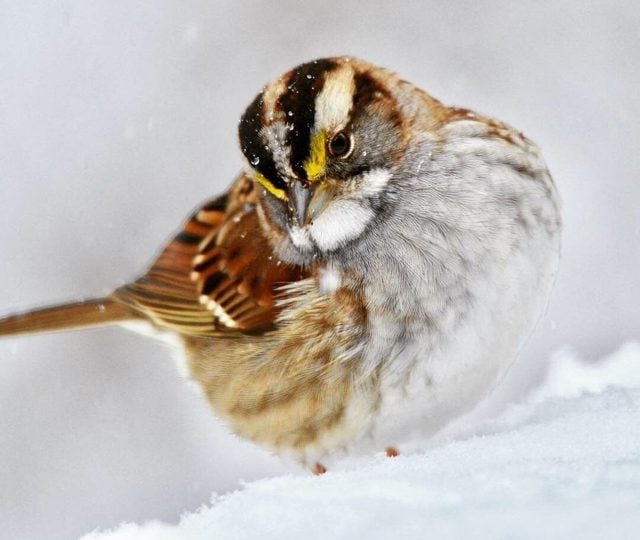
Abundant and familiar, the white-throated sparrow is easy to identify by its snowy bib. Until I spent some time in New England, I couldn’t figure out why people spell out the song Old Sam Peabody-Peabody-Peabody. Turns out the name is pronounced “Peabiddy” there—just as the sparrow says. White-throated sparrows are commonly spotted in the East, but are much less common in the West.
Don’t miss the 51 best winter bird photos.
White-Crowned Sparrow
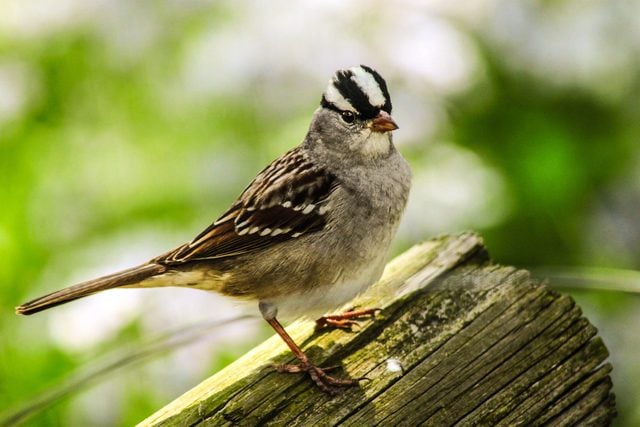
This dashing bird is an eye-catcher, its head topped with bold white stripes. This species leaves us about the time dandelions are turning to puffs: The parachute-topped seeds are a favorite food. Next time you see a white-crowned sparrow, consider the journey it’s about to embark on, which may take it to nesting grounds above the Arctic Circle. Time for an extra helping!
Discover more birds to look for in the snowy season.
Fox Sparrow

Even a brief visit from a fox sparrow—and that’s all we get in most places—is an occasion. Fox sparrows— among the largest and most beautiful of our native sparrows—spend the winter mostly in the southern states and go far north into Canada for the summer nesting season. They’re big, bold and a beautiful chestnut color (at least in the eastern U.S.) and, boy, can they sing! The key to identifying them is the mix of gray and foxy reddish brown, which is especially bright on the tail. In the West, their color is much duller, leaning toward gray in the Rockies and most of California, and brown along the coast.
Watch your feeders in winter for a common redpoll.
American Tree Sparrow
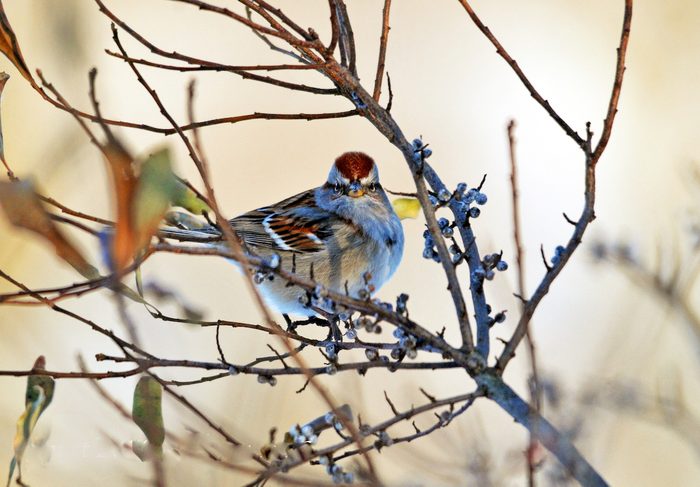
The American tree sparrow is one of the most common sparrows during the winter months in Midwest. Like the chipping sparrow, the tree sparrow also has a rufous cap, but it summers in northern Canada and Alaska.Learn how to attract birds in winter and spot more species.
Harris’s Sparrow
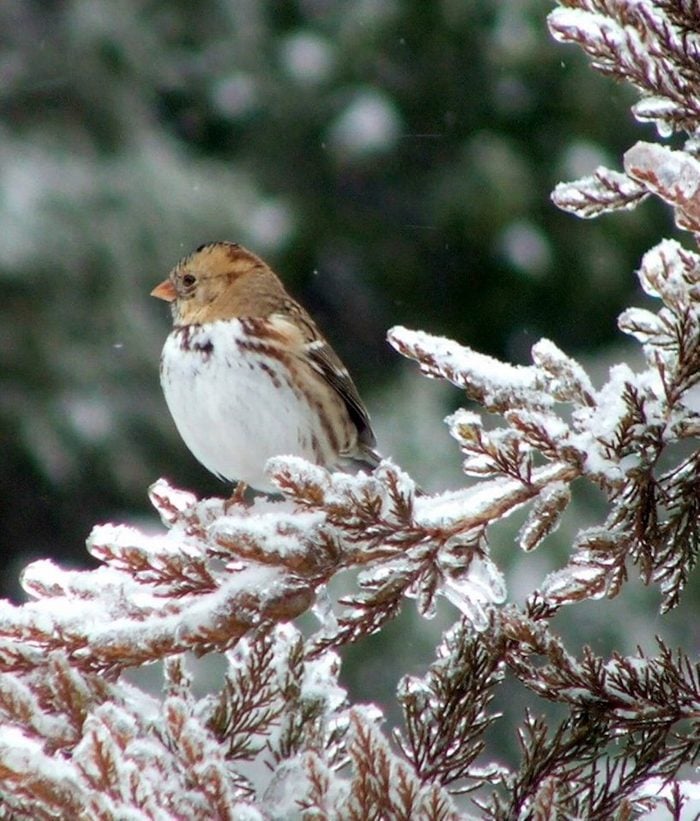
Watch flocks of winter sparrows and juncos for this species. According to the Kaufman Field Guide to Birds of North America, a stray Harris’s sparrow may turn up anywhere. In summer, they breed in Canadian spruce forests. Note the pink bill and white belly; adult birds have a black throat.
Psst—here’s how to help birds in cold winter weather.
Golden Crowned Sparrow

As their name implies, they’re cute little sparrows with bright yellow dots on the top of their heads. Their range is quite limited. Golden crowned sparrows spend summers in Alaska and western Canada, but are spotted in shrubby, weedy fields on the West Coast during spring and fall. Goldens stay on the ground, nibbling peanuts that other birds have dropped from the feeders.
Meet the 3 types of goldfinches in the United States.
Dark Eyed Junco

Black and white colored dark-eyed juncos are affectionately nicknamed snowbirds. These members of the sparrow family are sure signs that winter is just around the corner. Learn what juncos eat and how to attract them.
Spring Backyard Nesters
Many sparrow species may visit a feeder, especially during migration, but only a few are willing to call our backyards home. The sage sparrow, swamp sparrow, seaside sparrow and many others have specialized habitats that require more than the typical yard can offer.
Song Sparrow
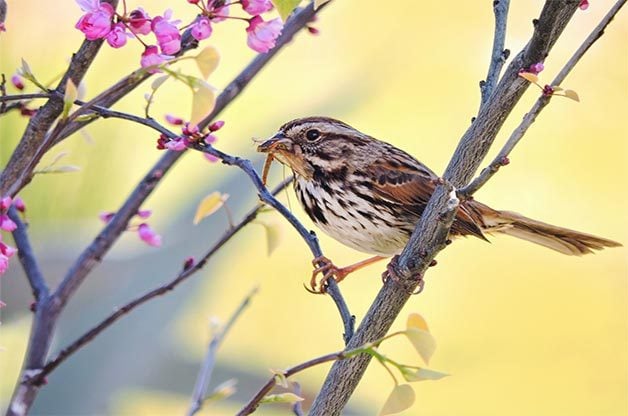
The most widespread sparrow, this year-round species begins singing in late winter, a welcome herald of spring. It often nests in backyards, tucking its deep cup of grasses right on the ground in your flower bed or strawberry patch. Song sparrows vary so much in coloring across their range that you may think you’re seeing several different species. Once they open their mouths, though, they all sound the same.
Check out 15 common backyard birds you should know.
Chipping Sparrow
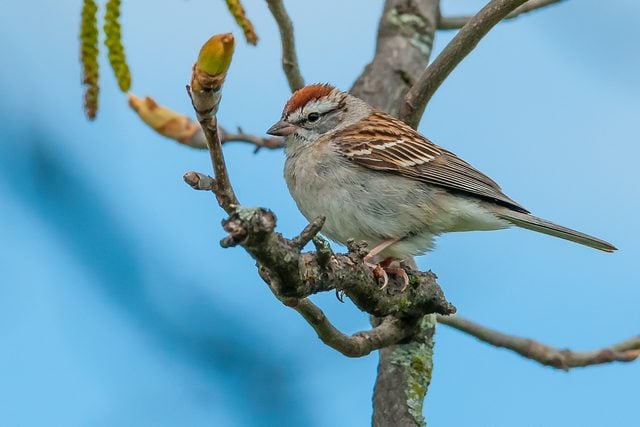
The monotone trill of the tiny chipping sparrow is easy to overlook in the spring chorus of birdsong. A resident during nesting season across most of the country, this little bird often hides its home in backyard shrubs. Watch for the cute little rusty-capped chippy hopping about on the ground to collect stray hairs from your dog to line its delicate nest.
Follow these proven tips to attract nesting birds.
Sparrows to Look for During Migration
Many native sparrows refuel at our feeders during migration, but not all become regulars. Keep an eye out for these little brown birds of the field when you’re hiking or driving. Depending on where you live, these widespread birds may be summer nesters or winter residents, or you may see them only as they’re passing through your area.
LeConte’s Sparrow
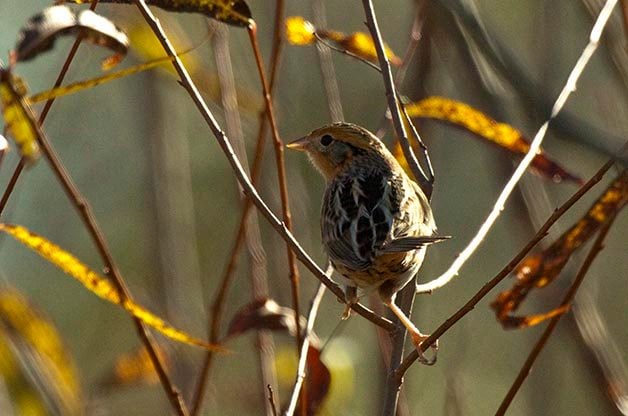
According to the Kaufman Field Guide, the Leconte’s sparrow is a shy bird that prefers damp fields and shallow marshes. Look for orange-buff face stripes and gray cheeks.
Nelson’s Sparrow

These sparrows migrate through the Midwest, and you have to really make an effort to head out to wetlands in order to find them. Many birders affectionately refer to these and Leconte’s as the orange sparrows. According to the Kaufman Field Guide, Nelson’s and saltmarsh sparrows were formerly considered one species.
Vesper Sparrow

This bird looks like a bigger song sparrow until its white outer tail feathers give it away. Its lovely music, too, resembles the song sparrow’s: a few whistles to start, followed by a quickening trill. Naturalist and essayist John Burroughs named the bird after the sweet, peaceful music of a sunset church service.
Savannah Sparrow
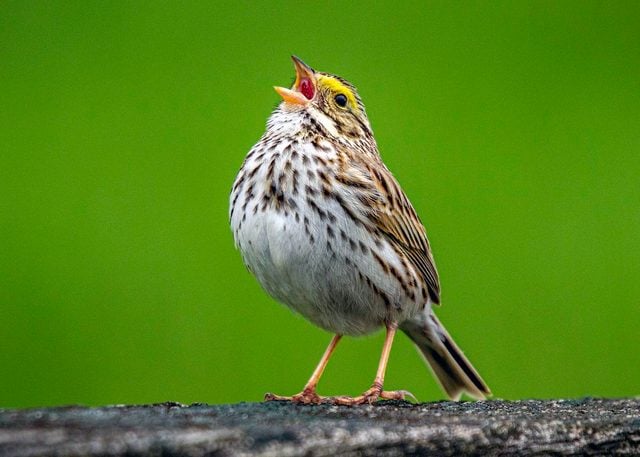
Grasslands across the country—also known as savannas or savannahs—are where you’ll find this bird. It’s the quintessential sparrow: a small, streaky-breasted brown bird that lies low until it’s time to sing. Then, look for the savannah holding forth from a fence post, road sign or tree. Savannah sparrows have a short notched tail and a yellow stripe over the eye.
Lincoln’s Sparrow

Lincoln’s sparrows are an uncommon species in the east, typically only spotted during migration. Its colors are helpful for checking this shy bird’s identity: The face is mostly gray, with reddish brown stripes along the sides of the crown. A buffy chest is marked with black streaks. Listen for a sweet, wrenlike song.
Black Throated Sparrow
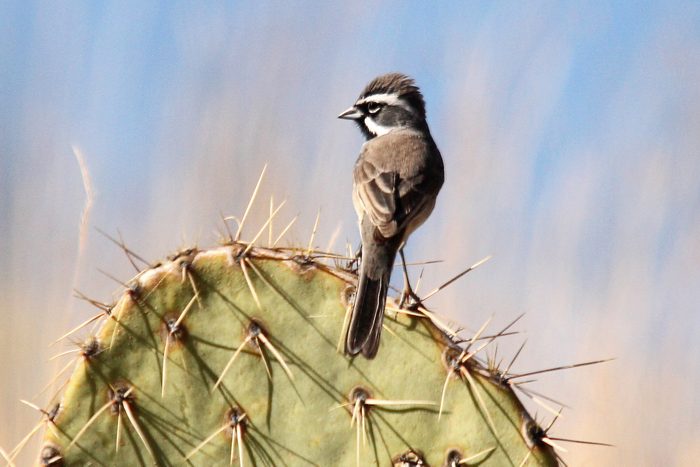
The sharply patterned black throated sparrow is a true desert bird, often going many days without water and living long distances from a water source. Black throated sparrows, found all over the Southwest, get enough moisture from consuming seeds and insects. Some migrate short distances, but they are year round residents along the southern U.S. border. Look for a black throat and mask with white eyebrow and whisker stripes.
Grasshopper Sparrow
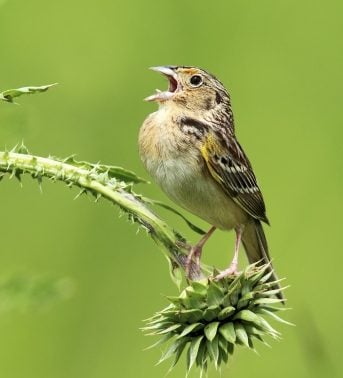
You’ll hear this small, shy sparrow way more often than you’ll set eyes on it. Why grasshopper? Two reasons: It lives in fields and pastures, and it makes a sibilant buzz very much like an insect’s. Like other grassland birds, its numbers are declining sharply, so look and listen while you can.
Non-Native Sparrows
House Sparrow
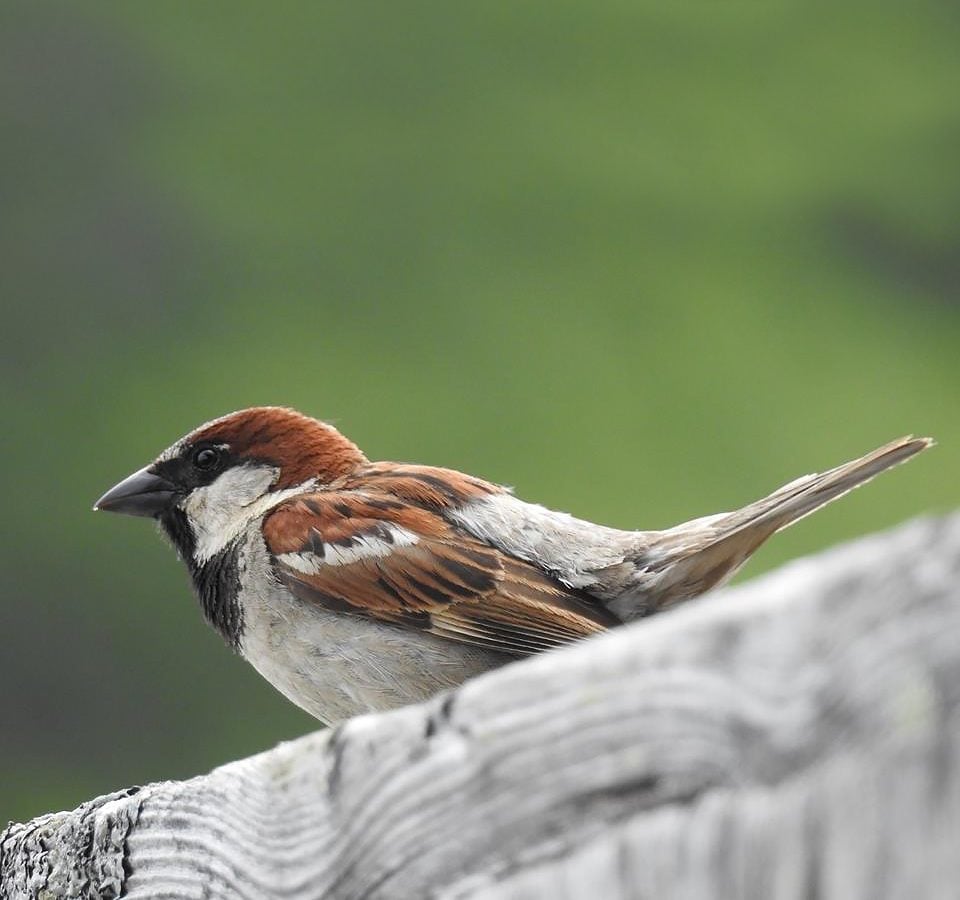
You’ve no doubt noticed one familiar sparrow missing from this list—the house or English sparrow. That one is an Old World transplant, unrelated to our native sparrows. Learn how to keep house sparrow nests out of bluebird boxes.
When dry leaves rustle beneath your shrubs, you may think it’s a fidgety squirrel at first, but look closer. If you hear an odd, sharp call through the noise, a towhee may be responsible for the racket. Crouch down low and peer through the dense branches to catch a glimpse of this secretive visitor.
A little larger than their sparrow relatives, towhees spend a lot of time on the hunt for seeds and insects by scratching at dry leaf litter on the ground. You might assume that a bird stands on one foot and scratches with the other, but towhees have their own approach: They jump in the air and kick backward with both feet, sending dry leaves flying and exposing their favorite foods.
On This Page
Eastern Towhee
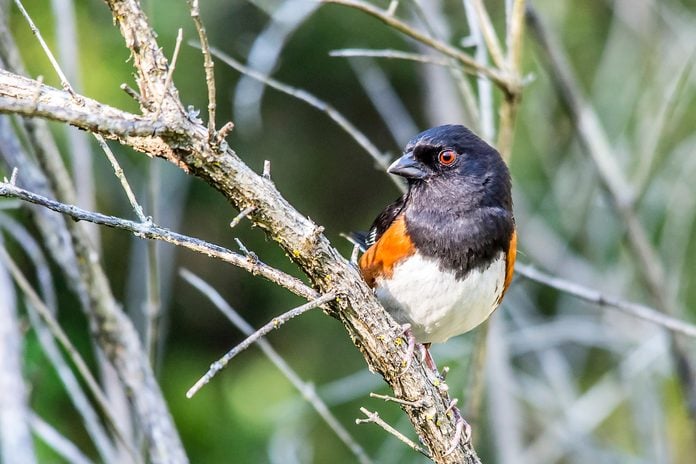
Anywhere in the eastern half of the U.S., scratching sounds that come from under dense thickets could reveal the presence of an eastern towhee. Males of this species are mostly black and white while females are mostly brown and white, but they both show a wide stripe of reddish brown, or rufous, along the side of the body.

Eastern towhee types thrive in second-growth woods, overgrown fields or tall forest edges, but they show up in backyards that have low, dense bushes. Listen for their sharp, ringing call, which sounds like chewink (or, if you use your imagination, towhee). Their song is a musical drink-your-tea.
Learn what a cardinal’s call sounds like.
Spotted Towhee

The western half of the country is the spotted towhee’s territory. It looks a lot like its eastern cousin and chooses similar habitats, but it has extra white spots on its back. Another difference is the calls and songs. Those of spotted towhees are much more variable.
Learn the best way to attract birds that don’t visit feeders.
Other Types of Towhees
Brown Towhee Birds

Two of the plainest brown birds in North America are the canyon towhee of the Southwest and the California towhee of California and Oregon. These two were once considered one species, called brown towhee, but their voices are completely different. What they lack in bright colors they make up for with personality. They live in pairs year-round, and the male and female both defend their nesting territory, loudly chasing away other towhees. And although the male does most of the actual singing, both members of the pair sing squealing, chattering duets together several times a day.
Learn how to identify and attract a chipping sparrow and a song sparrow.
Canyon Towhee and California Towhee

California towhees live near the Pacific coast in gardens, where they scurry across patios and bustle under hedges. Canyon towhees tend to live in the more wild country of foothills and canyons, but they come into the suburbs of some Southwestern cities, like Albuquerque.
Meet the white-crowned sparrow and white-throated sparrow.
Abert’s Towhee

There’s a third relative, called Abert’s towhee, with a very limited range. It lives along rivers and streams in Arizona and southeastern California, barely extending into the edges of other nearby states. Along wild rivers it can be very shy and hard to see. But in recent years some Abert’s towhees have adapted to living around people, and they have become common garden birds in some parts of Phoenix and Yuma, Arizona.
Learn how to identify a Lincoln’s sparrow and an American tree sparrow.
Green Tailed Towhee

Just a little smaller than other towhees, the green tailed towhee is mostly a western bird. It spends the summer in mountain forests, and for the winter it migrates to dense thickets along rivers and streams in the Southwest. As its name suggests, it has yellow-green on the tail as well as on the wings and back. However, you’re more likely to notice its rusty-red forehead—especially since it often raises those forehead feathers in a perky crest. The most common call note of this towhee is a soft mew that sounds like a kitten in the shrubbery.
Even though the green tailed towhee is typical of the West, it occasionally wanders far eastward and has even shown up at feeders on the Atlantic coast. Spotted towhees also stray east at times, and the eastern towhee occasionally drifts out west. So the next time you hear mysterious rustling coming from your shrubs, see if a towhee chose to visit your yard.
Easy Ways to Attract Towhees

- Habitat. Keep shrub branches low and allow dry leaves to accumulate under them.
- Food. Serve quality seed, like white proso millet. But don’t be surprised if towhees prefer to forage on the ground.
- Water. Put out a ground-level bird bath with a dripper or source of moving water.
Towhee Hot Spot
During your next visit to Arizona, add Saguaro National Park to your itinerary. Canyon towhees are common, spotted and Abert’s are present year-round, and green tailed ones visit during migration and winter. With luck, you could pick up four towhee bird species.
Next, learn about house sparrows: Least wanted backyard birds.
What Does a Song Sparrow Look Like?
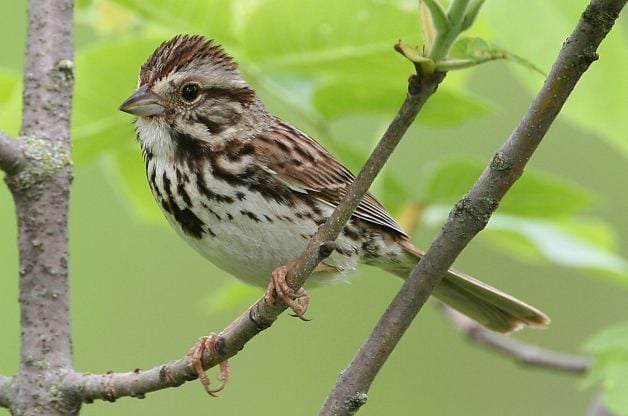
Distinctive markings: A song sparrow is coarsely streaked, dark on back and light underneath, with streaks on its sides that join to form a central breast spot. Its crown is brown with a narrow stripe, and a broader grayish stripe over each eye.
Birding experts Kenn and Kimberly Kaufman write, “These sparrows molt into a fresh plumage in fall, with brand-new feathers, so their markings are sharper from fall to early spring. By summer, after the adult birds have worked hard to raise their young, the feathers look more worn and frayed, and the browns may have faded to a more reddish brown. Typical markings include the face pattern, with its bold ‘whisker mark’ at the edge of the throat.”
Did you know: Song sparrows can be paler, darker, redder, grayer, larger or smaller, depending on your location. Ornithologists recognize dozens of subspecies of these adaptable birds.
Learn how to identify a chipping sparrow and an American tree sparrow.
Song Sparrow Facts

- Scientific Name: Melospiza melodia
- Family: Sparrow
- Length: 5-1/2 to 7 inches
- Wingspan: 8-1/4 inches
Meet the white-crowned sparrow and white-throated sparrow.
Nest and Eggs
This bird constructs a well-hidden ground or low nest of grasses, weed stems, leaves and bark fibers lined with finer materials. The three to five eggs laid inside are a dark-splotched greenish white.
Learn how to identify a Lincoln’s sparrow.
What Do Song Sparrows Eat?
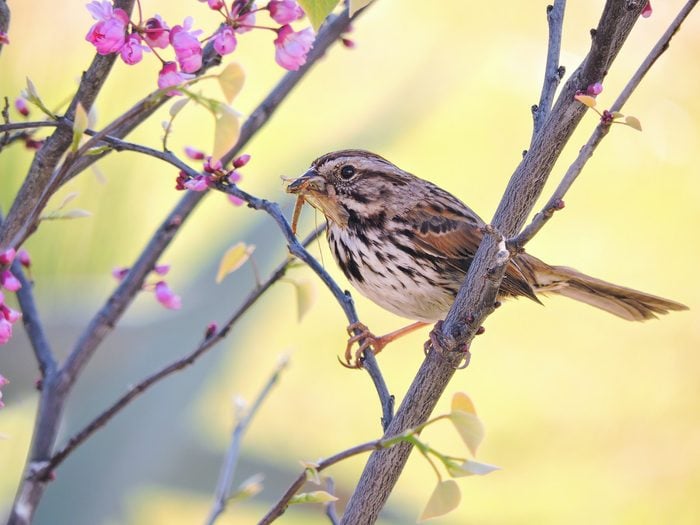
Diet: In fall and winter, song sparrows eat small weed and grass seeds. In summer, these small birds eat lots of insects. Attract them to a ground-level tray feeder with bird seed, located near a brush pile. If you’d like to bring more native sparrows to your yard, here’s how.
Psst—don’t forget native sparrows at bird feeders.
Song and Call
Listen for three clear notes of “sweet, sweet, sweet” followed by shorter notes and a trill. Its distinctive call note is “chimp.” Because they learn the structure of their music from others, local “dialects” are commonly heard. They are one of the top songbirds in America with the prettiest songs.
Hear the sound of the song sparrow’s song.
Bird songs provided by the Cornell Lab of Ornithology.
Range Map and Habitat
These birds like low, open, weedy or brushy areas around farms and residential areas.
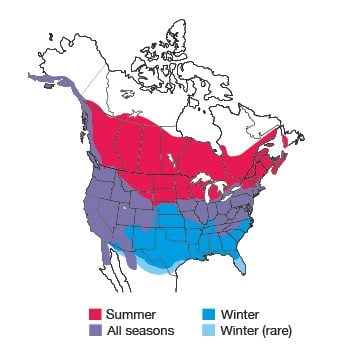
Range maps provided by Kaufman Field Guides, the official field guide of Birds & Blooms.
Next, learn about house sparrows: Least wanted backyard birds.

What Foods Do Woodpeckers Eat?
Snow, sleet and bitterly cold temperatures are no match for woodpeckers. Their can’t-miss black and white markings, with an occasional sprinkling of red, stand out as they acrobatically forage around bare tree trunks and brave the winter months. Find out what do woodpeckers eat, and offer the best woodpecker food at your feeders. Attract more woodpeckers with this simple yet satisfying menu.
1. Suet

Woodpeckers aren’t picky. You can make your own suet. Beef fat straight from the butcher will do; there’s no need to render it. Store-bought suet cakes get the job done, too. A basic suet cage feeder is inexpensive, and premade cakes slide right in for a perfect fit. Check out the best suet feeders for winter birds.
2. Peanuts

Shelled or unshelled, peanuts are a delicious snack that woodpeckers gobble up. You can find feeders made specifically for peanuts. Companies that sell nuts have jumped on the birding bandwagon and sell peanut feed that doesn’t make the cut for human consumption. Remember: Unsalted peanuts are best. Discover more backyard birds that eat peanuts.
3. Black Oil Sunflower Seeds

Downy and hairy woodpeckers are particularly fond of this all-around favorite. Because woodpeckers are a bit bigger than the average songbird, you should serve sunflower seeds in a hopper or platform feeder to give them easy access. Check out the best sunflower seed bird feeders for your yard.
4. Peanut Butter

Here’s an easy, no-fuss way to feed and attract woodpeckers: Simply smear peanut butter directly on tree trunks. Or buy a log feeder and fill the predrilled holes with the gooey, high-fat snack. Any regular brand of peanut butter that you have in the pantry will work, but avoid low-fat varieties.
Woodpeckers Species to Watch For
Next, find out why woodpeckers peck and how to stop it.

Just a few years ago, the words shade garden plants brought to mind hostas, ferns, impatiens and maybe some astilbe. Shady areas were viewed as a fine place to rest awhile on the garden bench, but not nearly as exciting as a sunny border.
Colorful garden plants for shade are still more limited than those for sun—especially now that impatiens no longer thrive in many areas due to a fast-spreading fatal disease. But foliage colors have exploded. And, oh, the possibilities! Today we can spice up our shade gardens with plants in bright lime, orange, pink, red, burgundy, purple, chocolate, near-black and every shade in between.
On This Page
Shade Garden Benefits
Birds and pollinators need shade gardens for food, nesting and shelter. Even gardeners benefit from cooler shaded areas. But finding plants that bring color, interest and activity to your shady spaces isn’t always easy. Consider plants known for bold foliage when you want to liven up low-light areas. Foliage plants are no longer considered accents: They are the foundation and the “flowers.” Invite different leaf colors and textures to mingle, such as frilly fern fronds and the lily pad-like leaves of ligularia plants.
And don’t forget about blooms! Plenty of colorful bloomers thrive in partial shade. Cool or light colors such as whites, pinks and blues pop in even the darkest corners of the garden. Finally, bring a buzz of pollinator activity. Plants native to your region should always be your first choice. Here are some shade garden plant picks to get you started.
Vibrant Foliage Plants for Shade Gardens
Leaves bring as much beauty to a shade garden as blooms. Available in an array of sizes, shapes and colors, plants with unique foliage add visual interest and diversity. Grow them in multiples for big impact.
Today’s splendid palette lets us use foliage plants as we would blossoms, creating color combinations that last all season. Easy-to-grow coleus, for instance, now comes in an unbelievable selection of luscious colors, with leaves ranging from simple shapes to frilly ruffles, in heights from 8 inches to 3 feet. As a bonus, the flowers attract hummingbirds.
1. Japanese Painted Fern
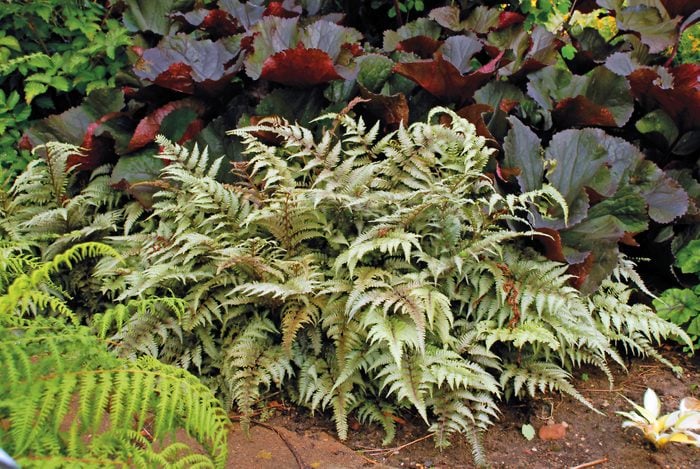
Anisocampium niponicum, Zones 2 to 9
Ferns have left good old green behind. For sophisticated texture and color, consider this woodland favorite. Take a look at the Lady in Red cultivar, with her lacy fronds and blood-red stems, or silver and burgundy Japanese painted fern, or the autumn fern Brilliance, which starts out coppery pink in spring, turns green for summer, then colors up again for fall. One of the showiest cultivars is Pictum, with silvery gray fronds and burgundy red stems. For a touch of flair, try Crested Surf, which sports two frilly tips on every frond.
2. Lungwort

Pulmonaria, Zones 3 to 8
This low-growing beauty boasts fuzzy spotted or striped leaves that rest below spring blooms in hues of blue, purple, pink, red or white. Morning sun and afternoon shade keep lungwort looking fresh.
3. Barrenwort

Epimedium, Zones 4 to 8
Dainty flowers in pink, purple, yellow or white appear in spring, but this plant’s main draw is its durable heart-shaped leaves. They make a trouble-free ground cover, tolerating both dry and moist shade.
4. Sun King Japanese Spikenard

Aralia cordata, Zones 3 to 9
With large chartreuse leaves that thrive in partial shade, this plant reaches 3 to 6 feet tall and wide. A deer-resistant stunner that lives up to its regal name, it was the Perennial Plant Association’s 2020 Plant of the Year.
Shade Plants for Hummingbirds
Many hummingbird preferred flowers grow best in sun, but some do offer blooms bearing rich nectar in shade. Bees, butterflies and other pollinators will also find and appreciate them.
5. Columbine

Aquilegia, Zones 3 to 9
Native species bloom in an array of colors, including red, yellow, orange, blue and purple. The bell-shaped flowers are nectar powerhouses. These 2- to 3-foot-tall perennials self sow and prefer soil that drains quickly.
6. Indian Pink
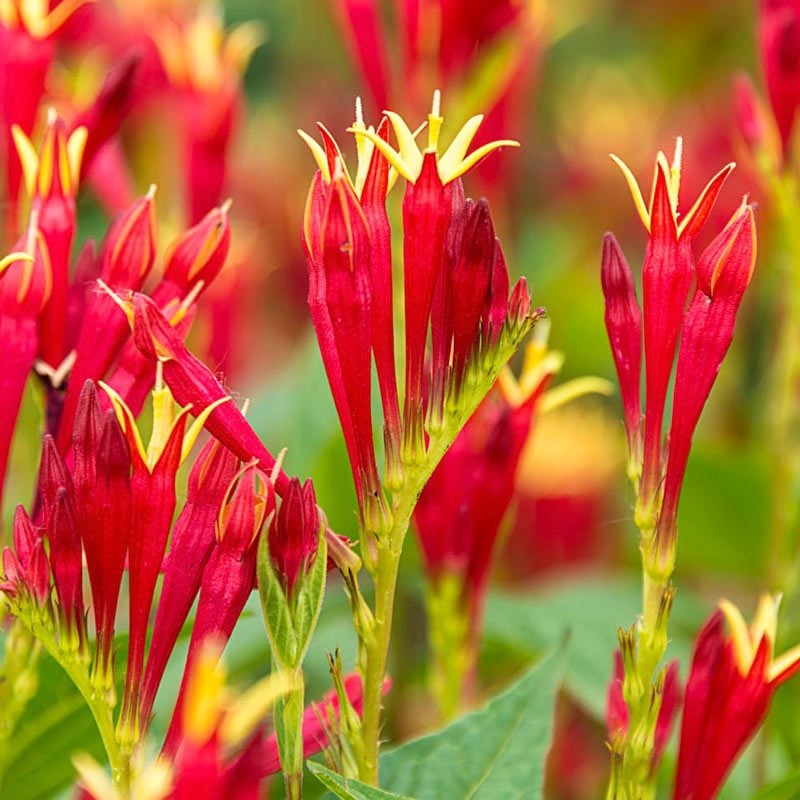
Spigelia marilandica, Zones 5 to 9
This 1-to-2-foot-tall native deserves a place in more shade gardens. The drought tolerant, clump-forming plants produce trumpet shaped red and yellow flowers that hummers flock to. Extend the bloom time by deadheading.
7. Cardinal Flower
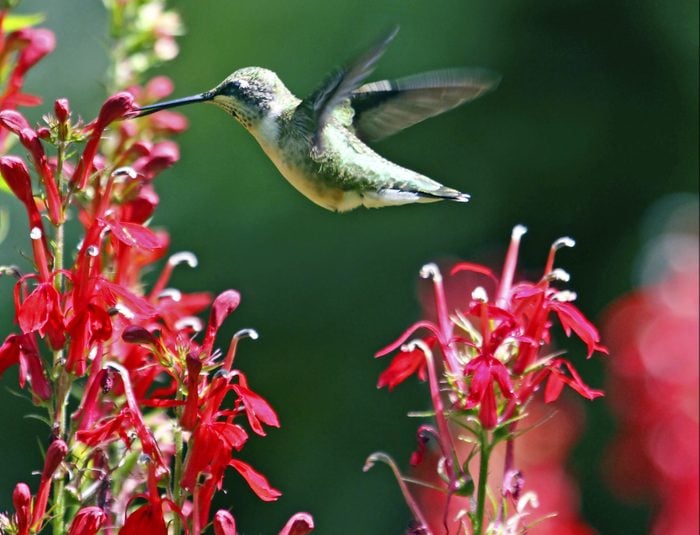
Lobelia cardinalis, Zones 3 to 9
With bright red or pink tubular blooms, this native does well in sun or part shade, provided it gets plenty of water. After cardinal flower‘s blooms fade, enjoy the fresh foliage and possibly a second bloom if you cut back the old spikes.
8. Hosta

Hosta, Zones 3 to 9
Mainly grown for its impressive foliage, this shade-garden favorite has flowers in hues from white to lavender that attract nectar lovers. To create a hummingbird buffet, plant fragrant varieties near red-blooming plants. Here’s what you should know about growing hostas.
Shade Plants for Butterflies
Butterflies float toward many of the same plants beloved by bees and hummingbirds, but they especially appreciate a shady landing pad where they can comfortably sip nectar.
9. White Wood Aster
Eurybia divaricata, Zones 3 to 8
Drought tolerant and easy to grow, this native blooms late in the season, providing butterflies with last-minute energy boosts. Tolerant of heavy shade, it grows 1 to 2 feet tall with a plethora of daisylike flowers.
10. Geranium

Geranium, Zones 3 to 8
Native geraniums, such as wild geranium, fit a wide range of growing conditions. Five-petaled blossoms in shades of pink, blue or purple grow on mounded foliage and are easy for butterflies to find and enjoy.
11. Ligularia

Ligularia dentata, Zones 4 to 9
These perennials boast an assortment of leaf shapes and sizes. If it’s butterflies you’re after, try Britt Marie Crawford with golden, daisylike flowers or Bottle Rocket with gold spires of blooms. Plant in moist soil.
Check out the top golden plants to make your garden glow.
12. Turtlehead

Chelone lyonii, Zones 3 to 8
Named for its flowers’ resemblance to openmouthed turtles, this late summer bloomer attracts winged visitors with its pink, purple or white blooms. A perfect pick for rain gardens or naturalized areas, it’s also deer resistant.
Colorful Shade Garden Plants to Try
Some plants flower well in shade, especially when given morning sun. These specimens’ showy blooms set the shade garden ablaze in color. But they have a lot more going for them, too—attractive foliage, interesting forms and more.
13. Coral Bells

Heuchera, Zones 3 to 9
The tiny flowers of heuchera, or coral bells, attract hummers, too, but it’s the sumptuous apricot, caramel, rose, lime or plum leaves of the new varieties that steal the show in the garden. Available in a wide range of leaf colors, these powerhouse plants are shade garden all-stars. Plus, the tiny flowers held aloft on wiry stems make good cut flowers.
14. Bee Balm

Monarda, Zones 3 to 8
This classic beauty produces more flowers in sun but can flourish when in shade, especially in hot climates. Most regions have a native or hardy species with pink, purple or red blooms that catch the eye with their spiky form.
15. Bellflower

Campanula, Zones 3 to 9
This huge plant family offers blooms in many shapes and sizes, though most come in hues of pink, blue and violet. A perfect option for partial shade is Serbian bellflower, a low-growing ground cover with starry bluish purple flowers.
16. Brunnera

Brunnera macrophylla, Zones 3 to 8
Its heart-shaped leaves with a silvery sheen and contrasting veins are unpalatable to deer. Sporting blue or white flowers in spring, the foliage of newer cultivars such as Silver Heart, Sea Heart or Jack Frost shine throughout the growing season.
Pink Shade Garden Plants
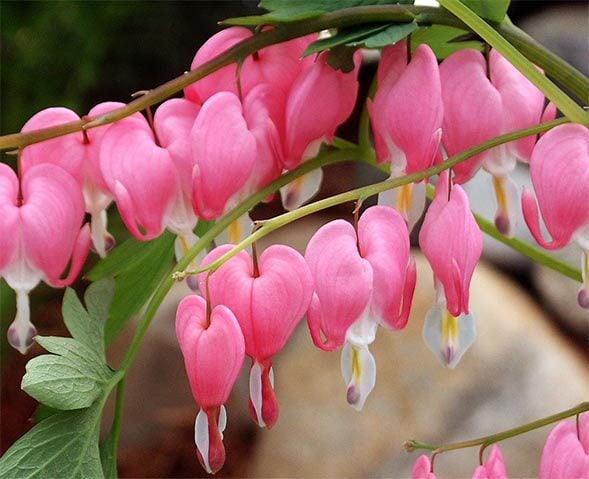
- Perennial: Astilbe, bleeding heart, fern-leaf bleeding heart, foxglove, Geranium cinereum ‘Ballerina’, hellebore, winter cyclamen
- Annual: Begonias, fuchsia, torenia
Red Shade Garden Plants
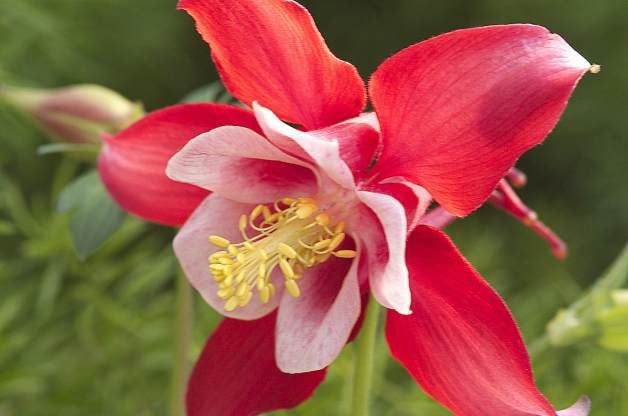
- Perennial: Astilbe, eastern and western red columbines, fire pink
- Annual: Fuchsia, begonias
Here are the top 10 red flowers that attract hummingbirds.
Yellow Shade Garden Plants
- Perennial: Lamium Hermann’s Pride, kirengeshoma, ligularia, wood poppy, woodland sunflower, yellow corydalis
- Annual: Monkeyflower, tuberous begonia
Discover the top 10 classic yellow flowers to grow.
Green Shade Garden Plants

- Perennial: Hellebore
- Annual: Nicotiana langsdorfii
Blue and Purple Shade Garden Plants
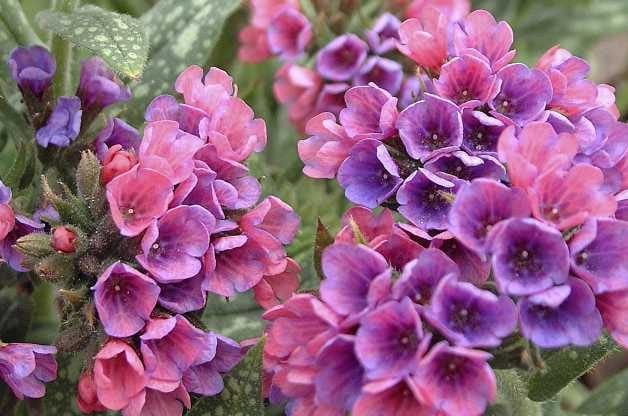
- Perennial: Blue wood aster, brunnera, Brookside hardy geranium, Jacob’s ladder, liriope, lungwort, monkshood, Phlox divaricata, Phlox stolonifera, Rocky Mountain columbine, Scilla siberica, toad lilies, Virginia bluebells
- Annual: Browallia, Summer Wave torenia
Psst—we found beautiful blue flowers and purple flowering plants for every garden.
White Shade Garden Plants
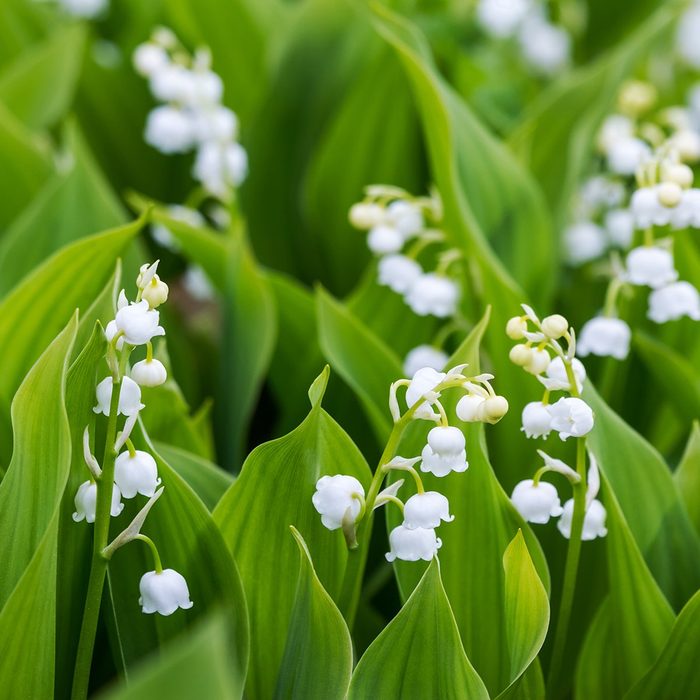
- Perennial: Astilbe, bear’s-breeches, Biokovo hardy geranium, hellebore, White Nancy lamium, lily-of-the-valley, snowdrops, tiarella, white wood aster
- Annual: Fuchsia, woodland tobacco (Nicotiana sylvestris)
Check out 15 beautiful white flowering shrubs.
Create a Calming Shade Garden Design
It’s easy to get carried away and come home with one of everything. But instead of throwing them all together, give your fancy shade garden plants room to shine beside quieter companions. Remember that serenity is one of the best things about a shade garden. Keep that peaceful feeling by separating different kinds of variegated plants with plainer companions so the leaves aren’t fighting each other for the spotlight. Use dark-colored plants, such as Osiris Café Noir ligularia, Hillside Black Beauty actaea or Chocoholic cimicifuga to create “shadows” between your bright-colored beauties so your eyes have a resting place.
Playing with color is the new trend for gardening with full shade plants. Free your fuchsias from the hanging basket and partner them with smoldering red coleus for close-up hummingbird watching. Spice up summer with copper plant (Acalypha wilkesiana), Dragon Wings begonia, pink polka-dot plant and red fuchsias.
Add zing to serene green and white hostas and ferns with a pool of blue Summer Wave torenia and an unexpected dash of hot sauce from orange and pink coleus. Mix and match whatever tickles your fancy, combining annuals and perennials with foliage plants that echo or contrast with their colors.
Choose the Right Plants for Shady Areas
Sure, you can get technical, plotting the arc of the sun and keeping track of how many hours your shady yard gets direct light, in which part of the day, in every season. But if you have a shady part of the yard, you already know it. Most shade plants do best in part shade or light shade—the usual conditions, even in many forests. Partial shade means a few hours of sun every day; light or dappled shade, created by shifting leaves, may get no direct sun at all, but it gets a good amount of light.
Learn what grass grows in shade and how to grow it.
Deep shade is an area where even indirect light rarely penetrates. It’s an uncommon situation, but you may have that, too, if you have buildings blocking the sun or other barriers. Most shade plants are very adaptable when it comes to the degree of shade they prefer. They’ll quickly tell you if you’ve guessed wrong. If they start looking weak and leggy, there’s not enough light. If their leaves crisp or curl or start looking bleached or browned, and you find yourself watering way too much, there’s too much sun. Move them, and try something that’s better suited to the original spot.
Garden centers make it easy by corralling shade plants into separate sections. Also stroll the shrubs and trees to seek out azaleas and rhododendrons, eastern redbud, dogwood, serviceberry, red-flowering currant and white sweetspire, all good bloomers in shade.
Consider houseplants, too. The filtered light in our houses is similar to outdoor shade, and croton, polka dot plant, Moses-in-the-boat, asparagus fern, Swedish ivy and abutilon (flowering maple) will thrive in the ground or in containers for a summer vacation.
Here’s how to tell if your plants need more sun.
Gardeners’ Favorite Shade Plants

“My coral bells plant amazes me year-round. I’m always impressed that it keeps most of its color and shape even through the winter. Also, few perennials come in as many colors as they do,” says Victoria Williams of Waterville, Ohio.
“Sweet William reseeds easily and butterflies love them, which is a bonus!” says Lenora Witt of Dennis, Mississippi.
“Elephant ears are a gigantic, lovely choice for shade gardens,” says Joan Heid of Chester, South Carolina.
“I love hostas. I have about 30 types. Their lush shades of green, blue and yellow are very comforting to me,” says Elizabeth Johnson of Rice Lake, Wisconsin.
“My favorites shade garden plants are astilbes. They’re beautiful in full bloom and offer interesting texture as seasons change,” says Laura Cox of South Dennis, Massachusetts.
“Solomon’s seal is my new favorite. Plants arch with pale green leaves edged in white. In spring, white bell flowers dangle from the stems,” says Juli Seyfried of Cincinnati, Ohio.
Next, check out the top 10 vegetables that grow well in shade.
Enclosed Bluebird Mealworm Feeder
Bluebirds like nest boxes and feeders out in the open. This bluebird feeder has a roof to offer protection from rain (which slides up for filling), clear sides for viewing, and two cups for mealworms and suet nuggets. Two side entry holes that are the perfect size for songbirds, but too small for starlings.
Check out our guide to feeding mealworms to birds.
Caged Bluebird Feeder
This small caged feeder is designed to keep squirrels and grackles out. We love how easy this feeder is to disassemble and clean.
Get proven tips on how to attract bluebirds.
Domed Bluebird Feeder
This domed bluebird feeder allows you to offer a full pound of mealworms or suet nuggets. The clear dome serves as a baffle to keep squirrels and bully birds like starlings and grackles out. The dish removes for easy cleaning and drainage holes keep food fresh.
What does it mean when you see a bluebird?
More Birds Hanging Bluebird Feeder
Sometimes you just want to keep it simple, and this blue plastic mealworm dish fits the bill (or beak.) It attaches to your feeder pole with a curved metal hanger. This bird feeder is also a perfect choice for offering grape jelly for orioles.
Learn how to identify a mountain bluebird, western bluebird and eastern bluebird.
Bluebird Flower Feeder
Flower lovers will adore this gorgeous bluebird feeder. The design looks like a blooming blue flower with petals on the side, and a sparkling blue crystal heart adorns the top to catch the sun’s light. If you like this floral design, you can also get it in orange as an oriole feeder.
Check out 8 ideas for attracting and feeding birds in spring.
Perky-Pet Dried Mealworm Feeder with Flexports
This feeder features flexports, so birds can remove the mealworms without making a mess. And you no longer have to worry about wind blowing away dried mealworms. The top removes for easy filling and cleaning.
Do bluebirds migrate in winter?
Red Cedar Mealworm Bluebird Feeder
This bluebird feeder is handmade out of red cedar wood with small 1 1/2 inch entrance holes to keep bigger birds out. Plexi-glass sides allow you a clear view of the bluebirds, and a hinged top allows for easy access to refill and clean the mealworm dish.
Learn how to make a DIY bluebird house.

Bluebird Feeder Tips
“Our bluebirds love suet but struggle on the suet cages, so we have a covered platform feeder where we leave some suet nuggets for them,” says Debby Miller of Middlefield, Ohio.
“Make a distinct noise every time you put out food to condition them to come,” says Karen Mullin of North Augusta, Ontario.
“My bluebirds fly to a certain spot and wait for me to come out with their mealworms. I love it when they begin to bring their baby bluebirds to the buffet!” says Anne Dudley of Stillwater, Minnesota. Learn when bluebirds nest and lay eggs.

“Bluebirds don’t seem too interested in our food supply, but they sure like to gather at the bird bath! Fresh water keeps them coming back,” says Kristen Clark of Tijeras, New Mexico.
“Offer dried mealworms—it’s easy to provide this source of protein,” says Laurie Dohrmann of Bettendorf, Iowa.
“I offer mine plenty of mealworms in a starling-proof bluebird feeder that’s mounted on a sturdy post with a predator guard,” says Vincent Drexler of Canal Fulton, Ohio.
“I use mealworms in a shallow, flat hanging feeder, and I always place bluebird houses on my deck rungs nearest the mealworms. Bluebirds seem to like that I put the food close to their nests. One season, we were lucky enough to have two broods. My best advice is to clean out the nest after their first brood so they return,” says Kathy Lorigan of Easton, Pennsylvania.
Next, check out 20 beautiful pictures of bluebirds.
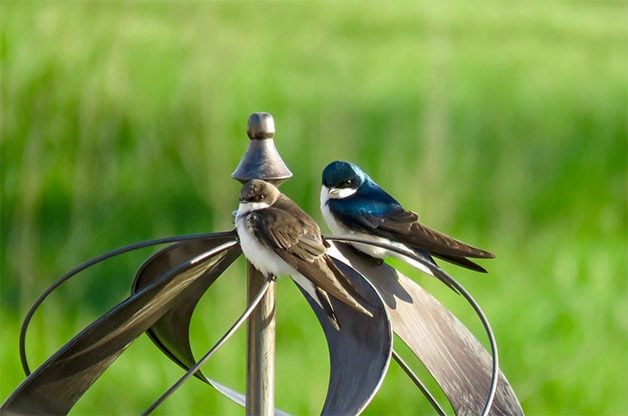
On This Page
How to Identify a Tree Swallow
Tree swallows are typically a straightforward enough bird to identify, even for newer birders. With shiny, almost iridescent teal upperparts and white below, they cut a striking figure as they swoop and dive through the skies after their preferred meal: bugs.
Audubon Upper Mississippi River’s Tara Hohman concurs. “Tree swallows are pretty easy and pretty simple,” she says. You’re going to be looking for white underparts, and more blue-green upperparts. Females, too, will have that blue-green, but it’ll be a bit more dull. Like other swallows, you’re looking for a small bird that’s more aerial and flying around, with more extended wings and a shorter tail.”
Look for a violet-green swallow in the West.
Nest and Eggs
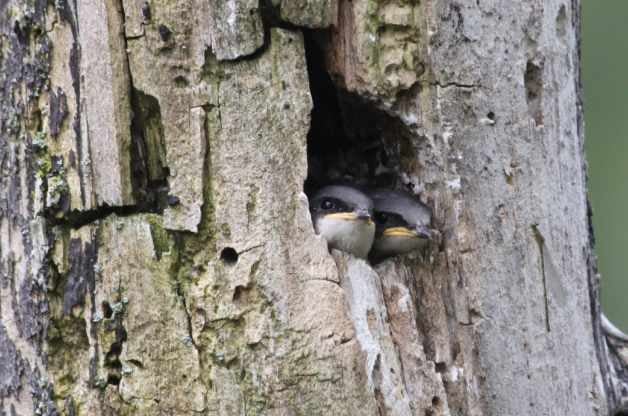
The female builds her nest in a cavity using grass, needles and feathers, and she lays up to eight white or pale pink eggs. Females have one or two broods each nesting season, and both parents help feed and protect young.
Nest boxes designed for bluebirds also attract this swallow, as Tara knows all too well. “We have about twenty bluebird boxes at the sanctuary where I work, and every single one of them is used by a tree swallow,” she laughs.” We’re right off the Mississippi river, too, so we’re the ideal habitat system to have them around.”
Learn more about swallows’ nests and nesting habits.
What Does a Tree Swallow Eat?
The hardiest swallow, tree swallows arrive early in spring and even overwinter in some localities. When insects are unavailable, they’ll feed mostly on bayberries; some wintering birds have also been seen picking seeds from pond ice.
“I wouldn’t necessarily call them feeder birds,” Tara says, noting that you’d typically be unlikely to find a tree swallow in your yard the same way you might more typical songbirds. “They like to be around water, and water and insects typically go hand in hand.” She mentions that a yard with a water feature or one that borders a river might bring in swallows, while urban or suburban birders might need to go elsewhere to spot them. “They’re not going to be coming in for things like seed or suet,” Tara says. “I haven’t seen them very often as a backyard bird.”
Don’t miss the 51 best spring bird pictures ever.
Tree Swallow Song
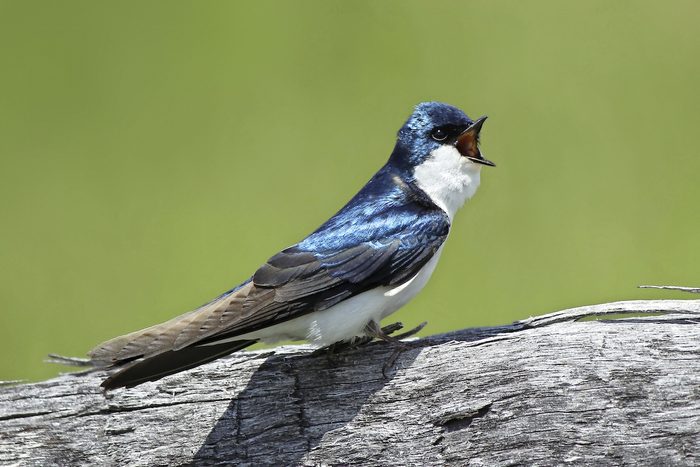
Typically an early-morning singer, a tree swallow’s song is a pleasant, gurgling chatter when in flight. “They have what some would describe as a clear, sweet, tittering or chirping call,” Tara says. “It’s similar to other swallows, but when you’re around it enough, it becomes distinct.”
Listen to the tree swallow’s song.
Bird songs provided by the Cornell Lab of Ornithology.
Meet the top songbirds in America.
Range Map and Habitat
If you live in the northern U.S., chances are good that you’ll be able to spot a tree swallow. They’re common summer visitors in the northern Midwest states, as well as the Pacific Northwest, the Northeast, and, less commonly, the Great Plains. When cold arrives, like many humans, they head to warmer climates. “They winter predominantly along the Gulf into Florida, but predominantly in Central America,” Tara says.
Cliff swallow vs barn swallow: spot the differences.
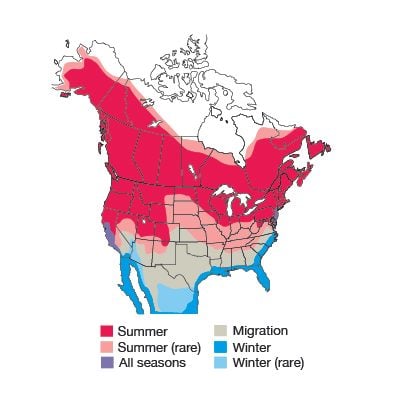
Range maps provided by Kaufman Field Guides, the official field guide of Birds & Blooms.
Ask The Experts

“I took this photo of a bird at a local park. Can you tell me what it is?” asks Birds & Blooms reader Cynthia Brennan of Glens Falls, New York.
Kenn and Kimberly Kaufman: Only half the bird is visible here, but that’s enough. The short, wide, flat bill suggests that this is a member of the swallow family. It feeds on flying insects, opening its mouth wide and scooping them from the air in flight. The fact that this bird is looking out of a birdhouse provides another clue. In eastern North America, the only swallows that nest in birdhouses are purple martins and tree swallows. The snowy white throat contrasting with the steel-blue top of the head makes this one a perfect match with the tree swallow.
Next, learn how to make a purple martin gourd house.
About The Expert
Tara Hohman is the conservation science manager for Audubon Upper Mississippi Flyway. Her scientific work has included point count surveys and avian monitoring for species such as golden-cheeked warblers, piping plovers, and more. She holds a Bachelor of Science degree in wildlife biology from Texas State University, and a Master of Science degree in environmental science and policy from University of Wisconsin – Green Bay.
Sources
- Audubon Field Guide, “Tree Swallow“
- Cornell Lab of Ornithology, “Tree Swallow: Overview“
When we were kids we all learned that birds fly south for winter. Even though it was probably one of the first fascinating facts you learned about birds, it’s not entirely true. Bird migration patterns have captivated and confused scientists and birders for hundreds of years. Early naturalists and philosophers often pondered where birds went in the winter. Some theorized that swallows and other species buried themselves in the mud. Others thought that birds wintered on the moon. At one point, the prevailing theory for hummingbirds was that they migrated on the backs of geese. We know now, of course, that none of these are true. We also know that it’s an oversimplification to simply state that birds fly south for the winter. Let’s explore some of the more interesting migration facts, including which species make the longest bird migration journey.
Why do some birds migrate while others don’t?
Bird Migration Patterns
Winter Travelers
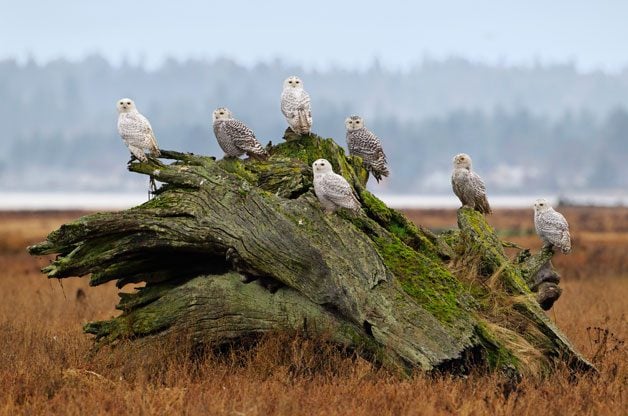
Migration doesn’t just happen in spring and fall. Winter movements of certain species are called irruptions. Unlike traditional migrations that occur every year, irruptions are more sporadic and driven by local conditions. Available food resources for northern birds, like conifer cone crops for winter finches or lemmings for raptors, can lead to mass movements of birds in search of food.
Snowy owls are likely the poster species for irruptions. It seems individual snowy owls have fan clubs when they arrive anywhere south of the Canadian border. Less noticeable irruption species include purple finches, pine siskins and redpolls. They might get mistaken for house finches or goldfinches as they nibble thistle seed in backyards across the northern tier of states.
Do robins migrate and return in the spring?
Altitudinal Migrants
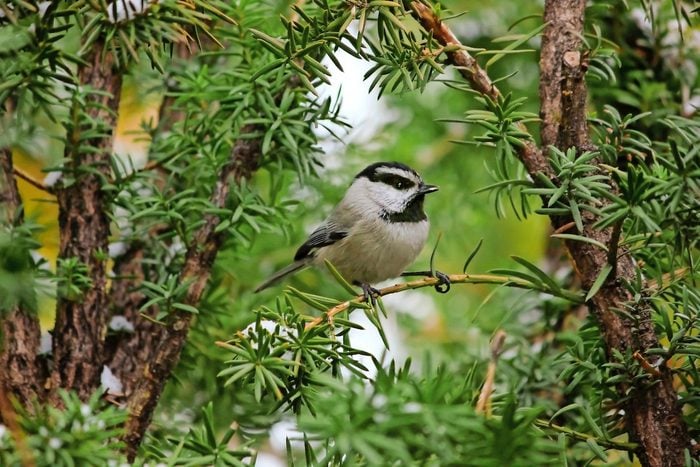
Migration doesn’t have to be a long movement across continents. There are plenty of species that demonstrate altitudinal migration. These birds will move to lower elevations during the harsh winter months. Mountain chickadees can occasionally be seen in towns near the mountains all year, but in the winter, the species moves to lower elevation, visiting feeders in striking numbers. Clark’s nutcracker, Steller’s jay and even the dark-eyed juncos can also exhibit this seasonal movement instead of traditional migration.
While plenty of mountain species move down the mountain during the winter, the dusky grouse of the Rockies moves uphill. These birds survive the winter by nibbling on conifer needles. Then, as the weather warms and food becomes more available, they will disperse back to lower elevations.
Baltimore oriole migration: Do orioles migrate?
Nomadic Migration
These nomadic species don’t move in a classic, seasonal pattern, but instead, wander throughout the year. It’s a highly specialized niche, and there are but a few examples of this behavior. Some populations of red crossbills move far and wide to areas with abundant cone crops. Their unique crossed bills make them dependent on specific food sources and they will move out of areas as food sources deplete. What is especially impressive is that crossbills can adjust the timing of their breeding to take advantage of abundant resources.
Learn about cedar waxwing migration.
Longest Bird Migration
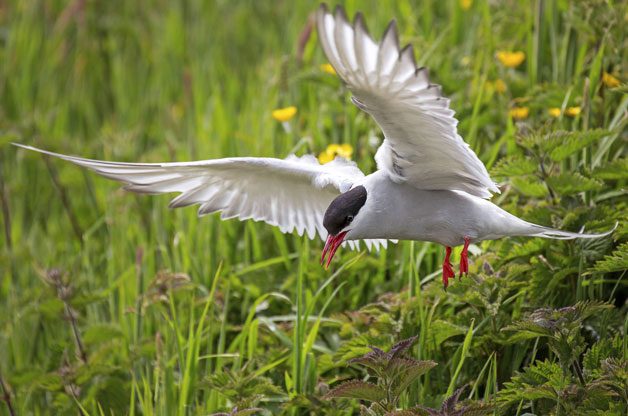
While numerous shorebirds and seabirds make epic migration journeys, the Arctic tern holds the worldwide title for farthest-traveling flier. This species follows the summers in both hemispheres. After a short nesting season in the high Arctic, this species heads south—extremely far south. They spend the nonbreeding season near Antarctica. They average an annual round trip of 49,700 miles from the Arctic to Antarctica.
Discover more surprising facts about Arctic birds.

Considering its small size, the tiny rufous hummingbird might be the most impressive migrator of all. Rufous hummingbirds have a circular migration route. From their winter ranges in southern Mexico, they work their way up the West Coast. Some will make it as far as southeast Alaska for breeding. Then by July, the males head south. They don’t follow the coast back, though. Instead they move from mountain meadow to mountain meadow down the spine of the Rocky Mountains. Occasionally a rufous hummingbird will drift farther to the east, and a few can be found in the upper Midwest and beyond each fall.
Psst—we have warbler migration tips for every type of birder.
How Do Birds Know When to Migrate?
Migration doesn’t flip on and off like a light switch. Many factors play a role in the movements of birds. Competition for nest sites and food availability drive migration patterns throughout the year. The length of days helps trigger migration.
Weather patterns will facilitate day-to-day movements. It’s easier for birds to fly with the wind than against it. Some birds will make epic nonstop journeys, but most take many stops along the way, each providing an opportunity to refuel.
For the irruptive finches and raptors of the north, flying south for winter can mean southern Canada and the northern United States. Neotropical migrants breed in North America and winter in Central and South America. Migration is a complex topic with endless nuances. There aren’t universal rules that apply to all birds. Even populations of the same species will migrate differently in certain instances. Migration is a fascinating topic and one that gets people excited about birds all year long.
Do bluebirds migrate in winter?
When Do Birds Migrate?
Somewhere on the continent, migration is happening nearly every day.
Waterfowl start to follow the open water northward as soon as they can. Spring bird migration is in full swing in the south by April, and in the north by late May. In early summer, spring migration is wrapping up for some northbound species while fall migration is kicking in for others. Fall migration sees southbound migrants, including hatch-year birds making the journey for the first time. Seedeaters shift across the regions as winter sets in. Even in winter we continue to search the skies, and our feeders, for winter irruption species, not to mention the resident birds that share our spaces all year long.
Check out 5 ways to attract migrating spring birds.
More Bird Migration Facts

- Every spring, approximately 500,000 sandhill cranes arrive along Nebraska’s Platte River before continuing north.
- Before leaving on their long trips, birds pack on extra fat, which can amount to 50% to 60% of their body weight.
- Radar technology first became a key tool for tracking bird migration during the 1960s.
- More than 350 bird species seen in North America migrate every year.
- The bar-tailed godwit takes zero breaks when flying from Alaska to New Zealand, a distance of more than 7,000 miles.
Next, discover 6 bird migration patterns that have changed.
What Do Dark Eyed Juncos Eat?

To attract a whole flock of juncos, you need to know what foods juncos eat. It takes a couple of feeders and the right plants to keep juncos full and coming back for more. Juncos are seedeaters; they’ll feed on seeds from your plants throughout much of the year. If you want to lure them to a feeder, offer black-oil sunflower seed or millet.

They’re ground feeders, so provide a large ground tray feeder like this one pictured above.
Dark eyed juncos reappear in many parts of the Lower 48 just as winter comes alive each year. They leave their breeding grounds in the Northwoods and the western mountains. Then they descend on backyard feeding stations across much of the U.S.
In winter, juncos feast on seeds of weeds and grasses that are left standing in your landscape or in fields, parks and open woodlands. Seeds from common plants such as chickweed, buckwheat, lamb’s-quarters and sorrel make up 75 percent of their year-round diet.
But juncos also supplement their diet with feeder foods. These snowbirds prefer to forage on the ground for millet, sunflower hearts or cracked corn that has fallen from your feeders. They may occasionally steal a seed from a platform or tray feeder. Or they may snatch a juicy berry from a fruit-producing shrub.
“It’s a joy to see our winter birds, such as this dark-eyed junco, arrive in Virginia during the fall because that always indicates the cool, crisp fall weather has come to stay. The juncos always seem so cheerful regardless of the temperature and appear to really enjoy foraging in the snow. This photo (above) is of a junco in a planter on our back deck,” says John Cushing.

- Diet: Seeds, nuts and grains in winter; insects, berries and grass seeds in summer.
- Backyard Favorites: Birdseed and cracked corn scattered on ground.
Next, here’s how to tell the difference between a junco vs chickadee.






